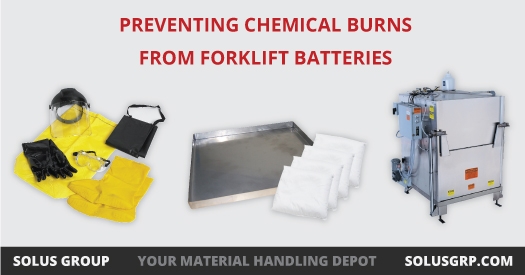We use cookies to make your experience better. To comply with the new e-Privacy directive, we need to ask for your consent to set the cookies. Learn more.
Preventing Chemical Burns from Forklift Batteries
Burn Awareness Week occurs during the first full week of February and reminds us of the grave importance of preventing chemical burns from forklift batteries. This annual occurrence provides a great opportunity for businesses to take a closer look at how they can avoid burns in the workplace and — when necessary — respond to them.
This is the perfect time for battery room operators to think about chemical burn prevention and response. Of course, managers mustn't overlook fire safety, but for now, we'll concentrate on the unique challenges of preventing and responding to burns from escaped battery acid.
As with so many problems, an ounce of prevention is worth a pound of cure.
Workers should always wear protective gear when handling forklift batteries with exposed cells. Even though working directly with electrolyte is inherently more hazardous than charging and changing forklift batteries, there are some commonsense solutions that make it less so. 
To start (and to comply with several OSHA regulations), all battery rooms should have Eye Wash Stations within 25 feet of battery handling areas. Additionally, workers should wear appropriate protective gear when cleaning or maintaining batteries.
There are also precautions that can be used for specific tasks. Here are some common battery room tasks and tips to make them safer:
1. Cleaning spilled or leaked electrolyte from drip pans.
To contain spilled or leaked electrolyte, battery room operators should place drip pans underneath all charging batteries. For maximum containment, use corner-formed Drip Pans, which eliminate welded seams and the corrosion that inevitably occurs in them. Durable, corner-formed Drip Pans eliminate leaks which could damage floors and burn workers.
Furthermore, lining Drip Pans with AcidSorb Pillows quickly neutralizes any spilled electrolyte, reducing the risk of chemical burns to employees. These high-capacity pillows make cleaning Drip Pans quick, easy, and safe — as long as battery room operators remember to change them out on a regular schedule.
2. Watering batteries from a jug.
Using Water Guns and carts instead of a jug is a safer way to water a battery after charging. The long nozzle keeps workers safely away from the electrolyte and the automatic shutoff ensures that the cell is filled properly. This one simple piece of equipment reduces the risk of injury while improving forklift performance through more precise watering.
3. Washing a forklift battery.
There are many safe ways to wash a battery. A Battery Wash Cabinet is one of the best because it fully encloses a battery. Other dedicated wash stations also do the job; just be sure that the station has three walls to contain water and that the washer has proper protective gear to protect him or her from splashes and sprays (especially over the face and eyes).
4. Cleaning up battery acid spills.
Lastly, cleaning up after boil-overs, leaks from charging batteries, or any other acidic spill or residue requires specialized cleaning products. Prepare your operation by providing Battery Spill Kits. These comprehensive kits provide workers with the neutralizing agents and the protective gear they need to safely clean spills.
When the worst happens, be prepared.
Proper equipment reduces the risk of accidents, but there's always a chance something will go wrong. That's why it's essential to educate employees on the appropriate steps if they come into contact with battery acid. Here's how to handle an industrial battery burn:
Remove any clothes that the battery acid has contaminated.
Flush the area with cool water for at least 30 minutes. Protect the victim's eyes and face from any contaminated water.
Any first-aid providers should be careful to avoid contact with contaminated water.
Quickly transport victim to emergency care after thoroughly rinsing the burn.
Chemical burns can cause serious injuries, but the quicker a victim can rinse the burn with cool water, the less severe it will be. That's why having working, clearly labelled flushing stations is so important.
Every operation should take some time to evaluate their processes and policies in regards to burn safety this Burn Awareness Week. Preparation and education prevent the serious injuries that can come with chemical burns from forklift batteries.
References:"29 CFR 1926.441 - Batteries and battery charging." OSHA. Occupational Safety and Health Administration, U.S. Department of Labor, n.d. Web. 7 Nov. 2017.
"29 CFR 1926.50 - Medical services and first aid." OSHA. Occupational Safety and Health Administration, U.S. Department of Labor, n.d. Web. 7 Nov. 2017.
"OSH Answers Fact Sheets - Battery Charging." CCOHS. Canadian Centre for Occupational Health and Safety, n.d. Web. 7 Nov. 2017.
